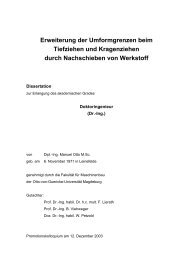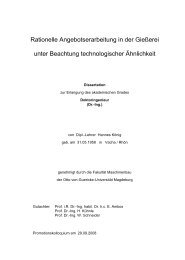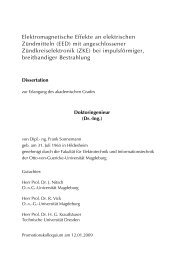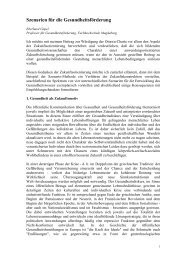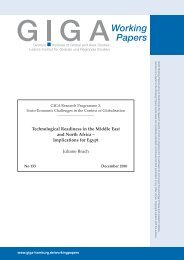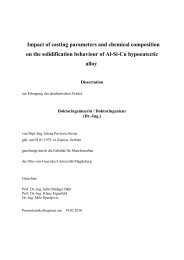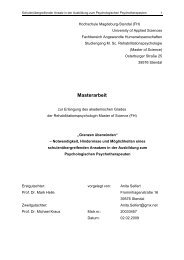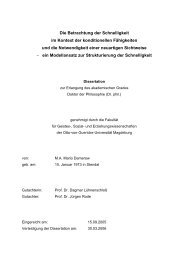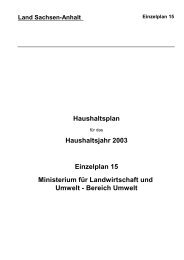Chapter 1
Chapter 1
Chapter 1
You also want an ePaper? Increase the reach of your titles
YUMPU automatically turns print PDFs into web optimized ePapers that Google loves.
Infrastructure services: Provision and has been low and costs very high, such as cargo handling<br />
maintenance and maritime transport. In maritime transport, the public<br />
sector Compagrie Tunisienne de Navigation (CTN) still<br />
Infrastructure capacity actually grew faster than GDP holds monopoly powers in Tunisia over the most important<br />
between 1990 and 1993 in telecommunications, transport regular lines (Tunis-Marseille), resulting in transport costs<br />
vehicles, and electricity distribution (table 2.3).' Particularly between Tunis and Marseille that are higher than between<br />
striking is the growth in road cargo vehicles after the gov- Singapore and Marseille. Likewise, the state-owned cargoerinent<br />
permitted private companies to enter the sector in handling firm STAM holds a monopoly in the Tunis ports<br />
1989/90. Utilization of all parts of the transport network (Tunis, la Goulette, and Rades). The government is well<br />
increased faster than GDP with the exception of sea pas- aware of these shortcomings and is in the process of<br />
sengers and rail transport (table 2.3). A recent survey ana- exploring all options, including privatization, to improve<br />
lyzing different factors that foreign businessmen consider in the situation.<br />
deciding where to invest ranked Tunisia's infrastructure Air transport (noncharter) is a monopoly of the public<br />
base (Tunis and Sousse-Monastir areas) as adequate or company Tunis Air. The current option under consideration<br />
good. The main area with less favorable ratings was is to sell 10 percent of its equity on the stock market, which<br />
advanced telecommunication services. 2 Although Tunisia's falls short of privatizing the company. Deregulation of pubinfrastructure<br />
services are generally good, the government lic bus passenger transport has been limited to two bus<br />
can further improve efficiency and increase competition licenses that have been granted on a restrictive basis for<br />
through: transport within Tunis and a few authorizations granted to<br />
* The deregulation of several state-run monopolies, taxi operators. A major opening of bus activity to the private<br />
enabling private sector entry and the more decentralized sector is not envisaged, because the government uses revprovision<br />
of some services; enue from its profitable lines to compensate for losses on its<br />
* Improvements in pricing and regulation policies, which more unprofitable lines. One option to explore is the possialso<br />
have a positive effect on the environment; and bility of deregulating the less profitable lines first.<br />
* Measures to improve expenditure allocations, particu- Telecommunications is a monopoly of the state, and the<br />
larly for operation and maintenance (O&M). government places a high priority on the provision of reliable<br />
phone services. Although new public investment<br />
Deregulation and increased efficiency increased from TD 43.4 million to TD 123.2 million<br />
between 1987 and 1994, the Government is unable to keep<br />
The deregulation of the merchandise transport sector began up with the backlog of connection requests (125,000 in<br />
in 1985 with a law opening regional merchandise transport 1993) and the continued strong growth in new demand for<br />
to the private sector. The law, however, was not enacted until phone connections (table 2.4).<br />
four years later. Since 1989 progress has been swift, with the Recent international studies point to the dramatic expanshare<br />
of private regional carriers in total merchandise trans- sion in the number and sophistication of new communicaport<br />
growing from 0 percent to 65 percent by 1993, with over tions tools to use and access information. Technological<br />
100 private carriers operating at the regional level. Transport change has stimulated the sustained growth of demand by<br />
fees have been lowered on average by one-third compared<br />
to the maximum fees charged by the public regional enter-<br />
reducing costs and prices while increasing the range and<br />
prises before deregulation, and some tariffs have been cut by TABLE 2.4<br />
as much as half. The experience has been positive, but the Demand for telephone connections<br />
intense competition has put the public transport enterprises (rh req )<br />
under increasing financial and managerial difficulties. The 1991 1992 1993<br />
Government is beginning to privatize these companies (four New demands 76.7 85.8 92.5<br />
out of sixteen have been sold).<br />
The Government has been more hesitant to liberalize<br />
other transport activities, even in cases where productivity<br />
New connecions<br />
WaitingE<br />
n<br />
a. Stock and unsatisfled new demand.<br />
Source: SIDES 1995.<br />
45.5 54.7<br />
~~141.1 143.4<br />
63.4<br />
125.0<br />
18 TuNIsi'S GLoBAL INTEGRATAON AND SUSTAiNABLE DEVELOPMENTf STRATEGIC CHOICES FOR THE 2 1sT CENTURY




